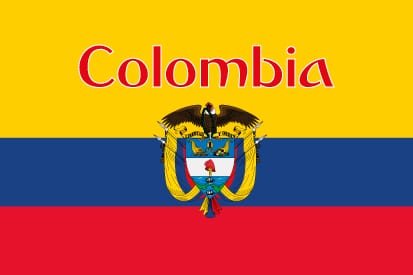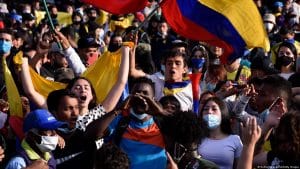Headlines
Colombia Population, Official Language And More.

Colombia has made efforts to achieve peace and stability in recent years, such as signing a peace agreement with the FARC in 2016, after four years of negotiations. The agreement aimed to end the armed conflict and address its root causes.


Colombia
The Population
- Colombia has a population of about 50 million people, making it the 29th most populous country in the world.
- Colombia is a multiethnic and multicultural country, with a diverse mix of races, ethnicities, and cultures. The majority of Colombians are of mixed ancestry, such as mestizo (European and Amerindian), mulatto (European and African), or zambo (Amerindian and African).
- Colombia also has indigenous groups that make up about 3.4% of the population, such as the Wayuu, the Arhuaco, the Embera, and the Nasa. They have their own languages, traditions, and territories.
- Colombia has experienced migration waves from various regions of the world, such as Europe, the Middle East, Asia, and Africa. Some of the most notable immigrant groups are Lebanese, Italians, Germans, Chinese, and Jews.
The Landmarks
- Colombia has many natural and historical landmarks that attract visitors and reflect its rich heritage. Some of the most famous ones are:
- The Cocora Valley, a scenic valley in the coffee region that has the world’s tallest palm trees.
- The Lost City, an ancient city built by the Tairona people over a thousand years ago in the Sierra Nevada de Santa Marta mountains.
- The Rock of Guatape, a giant monolith that rises from a lake and offers stunning views of the surrounding landscape.
- The Gold Museum, a museum in Bogota that displays the largest collection of pre-Columbian gold artifacts in the world.
- The Botero Museum, a museum in Bogota that showcases the works of Fernando Botero, Colombia’s most famous artist.
The Official Language
- The official language of Colombia is Spanish, which is spoken by more than 99% of Colombians. However, Colombian Spanish is unique and varies from traditional Spanish in other Spanish-speaking countries. It has clear pronunciation and regional dialects.
- Colombia also recognizes 65 other languages regionally, including indigenous languages, creole languages, Portuguese, and Romani. Some regions have their own official languages, such as English in the San Andres y Providencia islands.
The Culture
- Colombia has a vibrant and diverse culture that reflects its history and geography. Some of the aspects of Colombian culture are:
- Music and dance: Colombia is known for its musical genres such as cumbia, vallenato, salsa, merengue, and reggaeton. Colombians love to dance and celebrate with festivals such as Carnaval de Barranquilla, Festival de la Leyenda Vallenata, and Festival Iberoamericano de Teatro.
- Literature and art: Colombia has produced many renowned writers and artists such as Gabriel Garcia Marquez, Jorge Luis Borges, Fernando Botero, Alejandro Obregon, and Shakira. Colombian literature and art often explore themes such as magical realism, social realism, violence, and identity.
- Cuisine: Colombian cuisine is influenced by its diverse regions and cultures. It features staples such as corn, rice, beans, potatoes, plantains, meat, fish, cheese, and fruits. Some of the typical dishes are arepas, bandeja paisa, sancocho, ajiaco, empanadas, and tamales.
The Economic Stability
- Colombia has a market-oriented economy that is the fourth largest in Latin America and the 37th largest in the world. It has a GDP of about $282 billion as of 2020.
- Colombia’s economy is based on sectors such as oil and mining, agriculture, manufacturing, tourism, finance, and services. It is one of the world’s leading producers of coffee, flowers, bananas, coal, gold, oil, and emeralds.
- Colombia’s economy has faced challenges such as inequality, poverty, unemployment, corruption, violence, drug trafficking,
and armed conflict. However, it has also shown resilience and growth in recent years, thanks to reforms, trade agreements, peace efforts, and diversification.
- GDP: Colombia’s gross domestic product (GDP) measures the total value of goods and services produced in the country. According to MacroTrends, Colombia’s GDP for 2021 was $318.51 billion, a 17.9% increase from 2020. Trading Economics forecasts that Colombia’s GDP will reach $350.82 billion by the end of 2023.
- Currency: Colombia’s currency is the Colombian peso (COP). It is usually identified with the symbol . One US dollar is equal to about 4,068.90 COP as of today. The peso is divided into 100 centavos.
- Food: Colombian cuisine varies widely by region, but some common ingredients are rice, maize, potato, cassava, beans, meat, fish and seafood. Some of the most popular dishes are bandeja paisa (a platter of rice, beans, meat, eggs, avocado and more), arepas (corn cakes with cheese or other fillings), sancocho (a hearty soup with meat and vegetables), and empanadas (fried pastries with savory fillings).
- Major cities: Colombia has several large and important cities, each with its own culture, history and attractions. Some of the major cities are Bogotá (the capital and largest city), Medellín (the second-largest city and a center of innovation), Cali (the third-largest city and a hub of salsa music and dance), Cartagena (a coastal city with a colonial charm), and Barranquilla (a port city famous for its carnival).
- Major airport, sea port and schools: Colombia has many airports, sea ports and schools that serve its population and visitors. Some of the major ones are:
- Airport: El Dorado International Airport in Bogotá is the largest and busiest airport in Colombia and one of the most important in Latin America. It handles domestic and international flights from various airlines.
- Sea port: Buenaventura Port in Valle del Cauca is the main sea port of Colombia and one of the largest in the Pacific Ocean. It handles about 60% of the country’s maritime trade.
- Schools: Colombia has many public and private schools that offer primary, secondary and higher education. Some of the most prestigious universities in Colombia are Universidad de los Andes, Universidad Nacional de Colombia, Universidad de Antioquia, Universidad del Valle, and Pontificia Universidad Javeriana.
Continue Reading





